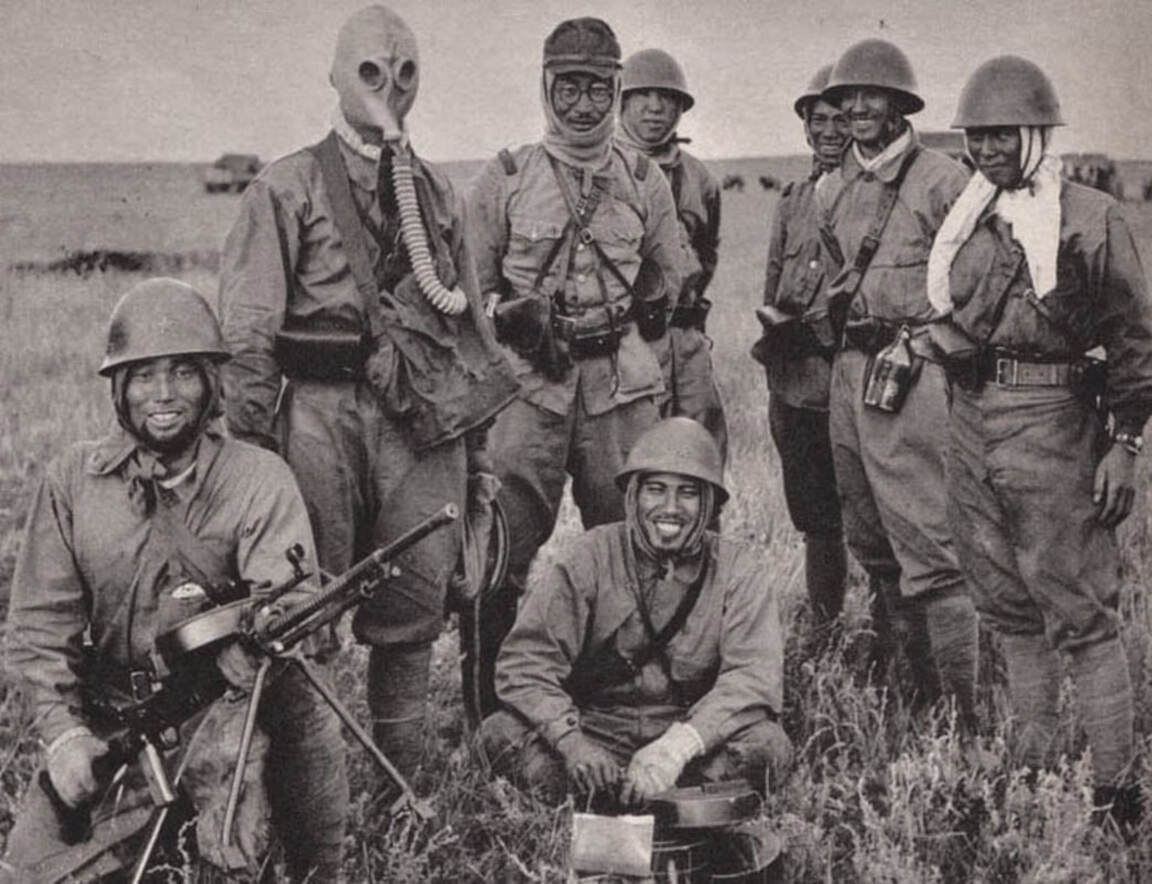Japanese Military Weapons - The Howa Type 89 rifle (89式小銃, hachi-kyū-shiki-shōjū), called the 5.56mm Type 89 Rifle (89式5.56mm小銃, hachi-kyū-shiki-go-t-go-roku-miri-shōjū) ,
The Type 89 was introduced to replace the Howa Type 64 battle rifle in front-line units, entering service in 1989. It has remained Japan's primary service rifle ever since. A limited number of Type 89 replacements, the Howa Type 20, were purchased in 2020.
Japanese Military Weapons
Like most other countries, Japan started the Cold War with a war rifle: 7.62 × 51mm NATO Howa Type 64. replaced by assault rifles, which fired intermediate cartridges, although they had a lower effective range than war rifles. The 5.56×45mm (SS109) round, first used in the M16 rifle, eventually became the standard ammunition type for all NATO member assault rifles. In line with this, Defse Agcy started developing the next generation assault rifle to replace the 7.62×51mm Type 64 battle rifle after 25 years of service.
New Great War Episode: World War Zero
Development was primarily handled by Howa as it had been licensed to produce the AR-180 version of the Armalite AR-18 rifle for commercial purposes, and in some ways the internals of the Type 89 were similar to the AR-18 - the Type 89 used the same short-stroke gas piston system and rotating bolt as AR-18, but not dual recoil springs.
To determine the rifle's suitability, it was issued in limited numbers to the Japanese Self-Defense Forces for field testing purposes. After the data gleaned from the AR-18's field testing phase was reviewed, the formal development of the next generation assault rifle began with its designation as the HR-16 (HR1604).
The HR-15 was the first version of the experimental rifle that eventually became the Type 89, but was developed simultaneously with the HR-10, HR-11, and HR-13 in 1989.
On December 6, 2019, the Japanese Ministry of Defense announced that plans had begun to convert the Type 89 into a new 5.56-caliber assault rifle.
Okinawa Key To Japan's Defense Against China, North Korea, Says Expert
In 2020, the Howa Type 20 was developed, which was expected to replace the Type 89 as Japan's service rifle.
One of the most advantageous features of the Type 89 rifle compared to the Type 64 was the ability to lighten the load on the individual soldier in relation to the amount of ammunition he could carry. Also, due to the use of aluminum and thermosetting plastic in the steel and wood construction of the Type 64 rifle, the speed at which the soldier can react to the threat is increased. The fixed stock version of the gun contains a storage compartment covered by a rubberized cap that can be accessed by pulling the cap away from the body of the gun and twisting it in either direction. Although the typical issue model features a fixed stock, a small number of versions with a folding steel tube stock have been produced for AFV aircrews and paratroopers.
The fit and finish of the Type 89 has been greatly improved over the Type 64 by using forged aluminum, molded thermoset plastic, and stamped steel manufacturing methods pioneered from the process used to produce the AR-18 and Heckler & Cook G3 series rifles. .

The Type 89 was designed with simple operation and a minimum number of parts due to the realization that the complex structure and large number of parts are responsible for the often faulty operation of the Type 64 gun.
With Little Fanfare, Japan Just Changed The Way It Uses Its Military
Therefore, the cost of the Type 89 rifle is about half that of the Type 64 rifle from 870,000y in 1989. According to Defse Agcy, the unit cost of the Type 89 rifle was reduced to approximately 340,000y in the 2005 fiscal year.
However, it is still considered too expensive for public issue because the ideal price charged by the Japanese government for public production is 10,000 to 100,000 per unit. This is further complicated because the weapon procurement method is limited to accounting for a single fiscal year, and now there are no further cost reductions in the manufacturing process.
However, the magazine made specifically for the Type-89 uses a specially shaped follower to hold the bolt open after the final round has been fired. If an M16 series magazine is used, the bolt will not lock after the final round expands. The magazines designed for the Type 89 also differed from those produced for the M16 in that they had a hole in the side of the body to indicate whether it had been loaded with 30 or 20 rounds of ammunition. However, this comes with a hidden cost to allow sand and other foreign substances to easily enter the magazine and cause malfunctions in the functioning of the firearm.
Unlike the M16, the Type 89's magazine well is not modified or tapered because the lower receiver is only slightly wider than the magazine body, making it more difficult to reload the rifle.
Japanese Ground Self Defense Force (jgsdf) Soldiers Unload Weapons And Vehicles From A Landing Craft Air
The Type 89 rifle ammunition is interchangeable with the 5.56×45mm SS109/M855 round used by the US military and NATO.
Together with the 7.62×51mm round used in the Type 64 rifle, this allows for exchange with the ammunition stockpiles of the US forces stationed in Japan. Since the ammunition developed for the Type 89 rifle was produced in Japan, the Self Defense Forces sakura mark is stamped on the muzzle instead of the NATO circular cross normally used on the SS109 / M855 round.
The selector is located on the right side of the lower receiver and is often called "Atare 3" (アタレサン Ataresan アタレ(Atare) means "press") in reference to the different selector positions. The signs and related features are as follows in functional order:

Its 3-shot burst function is built separately from the others, so as to prevent the selector from being useless if it cannot be used due to an accident or malfunction.
Japanese Army Soldiers Clear Their Weapons Before Entering Their Military Base In The Southern Iraqi City Of Samawa, January 10, 2005. Japan's Prime Minister Junichiro Koizumi Reiterated Last Month That He Wanted
A bayonet made specifically for the Type 89 rifle can be used as a wire cutter by attaching it to the lug on the scabbard. Also, d of bayonet scabbard can be used as a bottle opener. The US Army M9 bayonet can also be mounted on the rifle.
To aid accuracy, which is also on the Type 64. However, unlike the bipod on the Type 64, the version on the Type 89 is easy to remove as it is attached to the barrel behind the bayonet lug with a clip-style spring mechanism and held in place by a lever lock. Additionally, the Type 89 handguard is machined with an inlet along the bottom edge to accommodate the bipod legs if they are folded inward for storage.
Special Forces units of the Japanese Self-Defense Force are also equipped with pressure-activated switch-activated targeting lasers and flashlights mounted on the weapon barrel in front of the forward assembly. Ordinary members of the Self-Defense Forces can also receive them, but they must pay from their own funds.
Modifications were made to the Type 89 due to the deployment of weapons directly to Iraq from members of the JSDF, as well as public concern for counter-terrorism and possible future combat deployments. In accordance with the "Iraqi Uprising Support Act on Special Actions on the Ground for the US Military" (イラク復興支持特悒法) or "Iraqi Self-Defense Forces Dispatch Law", the selector is created and installed on the lower left side. receiver for ambidextrous use for rifles issued to members of the JSDF in Iraq.
Has Japan Just Given Up On The Tank?
However, this is only a temporary modification and the gun must be returned to its original condition (with the selector on the right side only) when it is returned to Japan.
In 2004, JSDF elements that have the ability to see combat were issued an optic (a red dot unmagnified sight) with their Type 89 along with a mounting bracket to reduce target acquisition time.
However, because the use of sights is still in its preliminary stages, individual members of the JSDF must purchase their own commercially available models for use in possible combat theaters. Among the commonly used optics is the MD-33 manufactured by Tasco Optics Japan under license.

In the initial deployment to Iraq, JSDF elements who have the ability to see combat (eg Western Army Infantry Regimt) were issued with separate hand grips.
Silent Sentinels Of Kiska (u.s. National Park Service)
And 25mm Weaver rail was installed on the front handguards of their Type 89s to accommodate. Not long after, the ban was lifted and all units began to accept the front held despite general complaints about the damage to the handguards caused by Gunung. However, the JGSDF has banned the attachment of the front grip for fear of damage.
A three-point sling was issued to JSDF elements who were given the opportunity to witness combat thanks to positive testimonies from various international military and police forces.
The supplied three-point webbing is black (as opposed to olive green for the standard webbing), with the same buckle as the webbing.
Military drone range, laser range finder military, military range bags, military range targets, long range military radio, military radio range, military range finder, military long range binoculars, range rover military discount, military range rover, range of military drones, military range bag
0 Comments